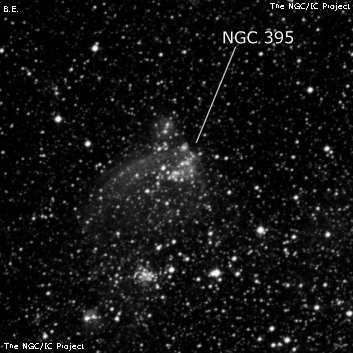
IC 1624 appeared about half the size of NGC 395, roughly 1' in diameter with a mottled appearance and no central condensation or resolution. A mag 13 star is close west with a mag 11 star 2' W (supergiant SK 118). A very small nebulous knot (SMC-N78C) was also noted ~2' SE. A large, scattered group of stars (OB-association) is superimposed on the field.
James Dunlop probably discovered NGC 395 = D 35 = D 34? = h2379 on 1 Aug 1826 with his 9" reflector and recorded (for D 35) "a very small faint nebula, with a small star in the south margin." He made two observations of D 35 and one observation of D 34 and his published position for D 35 is 7' too far south. John Herschel made a single observation on 5 Nov 1836 and recorded "very faint, pretty large, round, gradually a little brighter in the middle; 2' across." His position and description is accurate and no mention is made of Dunlop's possible discovery. See NGC Corrections list from Harvard College Observatory and the IC 2 notes/corrections, DeLisle Stewart.
400/500mm - 18" (7/6/02 - Magellan Observatory, Australia): easily picked up in the same field as brighter NGC 371. At 171x, this object appeared as a moderately bright 4' round knot of mag 14 or fainter stars with a good response to the UHC filter (the emission component is SMC-N78). The surface brightness was fairly high with the filter although Hartung just described this object as a "star group". NGC 395 forms a pair with IC 1624 3.2' SSE. Located 8' NE of NGC 371.
Notes by Steve Gottlieb